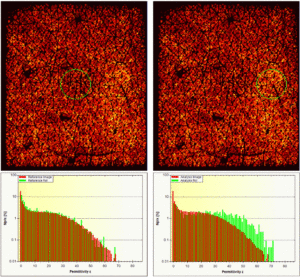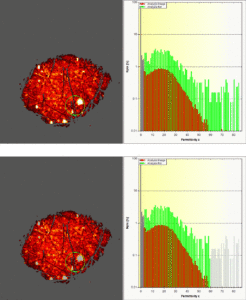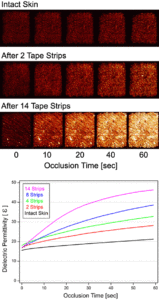This article illustrates how biometric fingerprint sensors that respond to touch can be used for characterising static and dynamic properties of skin, including Stratum Corneum (SC) hydration and micro-relief. However, the fingerprint sensors themselves are ill-suited to accurate hydration measurement because of their limited response range, non-linearity and non-uniformity.
These limitations have been overcome in the Epsilon Model E100 contact imaging system (Biox Systems Ltd, England), whose proprietary calibration technology delivers SC hydration measurements that are more accurate, more versatile and faster than conventional instruments.
More accurate because measurement errors associated with less than perfect skin contact, and skin surface water from topical products and insensible perspiration can be eliminated using its unique image processing features. More versatile because the Epsilon can be used on less than ideal skin sites such as unshaven skin, wrinkly skin, skin at skeletal joints and other non-flat skin areas. Faster, because mean hydration and hydration heterogeneity in multiple regions of interest (RoI) can be assessed in the same image.
Recent research has shown that biometric fingerprint sensors that respond to touch can also be used for characterising static and dynamic skin properties including SC hydration and micro-relief [1-4]. With a typical spacial resolution of 50μm and a 1/e sensing depth of ~5μm [5], these sensors are well matched to the characteristic dimensions of SC and other bio-tissues such as mucous membranes and even hair.
However, whilst such sensors are excellent for visualisation, their measurement performance is limited by :
(i) their narrow response range where readings are frequently off-scale,
(ii) their non-linear response to capacitance and therefore to hydration, and
(iii) their inconsistent response from chip-to-chip and from pixel to pixel.
These limitations are overcome with the unique linearisation and calibration technology of the Epsilon Model E100 contact imaging system. In consequence, Epsilon images can be used for both visualisation and measurement of SC hydration in a consistent way from instrument to instrument and from time to time.
The Epsilon can measure skin hydration with great accuracy and flexibility than conventional single-sensor probes. The Epsilon with 76800 sensors has a sensing depth that confines the measurement predominantly to the SC. That’s a game-changer because skin is heterogeneous and skin-sensor contact is variable.
The Epsilon measures hydration using its calibrated dielectric permittivity (dielectric constant, ε). This works because the dielectric permittivity of water is much higher (ε ~80) than that of other constituents of skin.
Materials and Method
The measurements presented here were performed on normal skin in-vivo in ambient conditions of ~21oC and ~50% relative humidity.
The images were recorded using an Epsilon Model E100 contact imaging system, as depicted in Fig. 1.

The Epsilon uses a semiconductor fingerprint sensor with 76800 individual sensing elements spaced 50µm apart in an array of dimensions 15mm x 12.8mm.
The 1/e sensing distance into the skin is ~5µm. The probe can also be mounted in an in-vitro stand for static and dynamic measurements of moisture, moisture-loss and diffusion using samples such as skin surrogates, hair, powders, liquids, gels, etc.
The Epsilon probe connects to a Windows PC or laptop with a standard USB cable for both data and power. Fig. 2 shows a screenshot of the Epsilon software, where hydration images can be displayed using one of six false colour scales, red/yellow in this case. The black regions of the image have the lowest hydration readings, which are associated with micro-relief lines, hair and bad skin contact. Dark red indicates low hydration, bright red going to yellow indicates increasingly high hydration. The two graphs on the right show the time-evolution of mean hydration and a histogram of hydration distribution respectively, with the colour-co-ordinated red line giving information about the whole image and the green line giving information about the circular RoI.
Fig. 2: Screenshot of the Epsilon software in live streaming mode, ready for image, burst or video capture.
The software has facilities for live streaming and image capture in Snapshot, Burst and Video modes. A unique image capture feature is event triggering, where image or video recording is initiated by touch with the site of interest. Analysis functions include area and permittivity time-series, permittivity filtering and skin topology (micro-relief) characterisation. Images are saved in industry-standard formats (lossless tiff & avi) that are compatible with third-party software such as Photoshop.
The examples shown in this section illustrate the hydration measurement capabilities of the Epsilon capacitance contact imaging system.
1. Hydration Heterogeneity Assessment
Epsilon images provide a revealing visualisation of hydration distribution in the vicinity of the site of interest. The images can be processed to give quantitative measures of heterogeneity as either Standard Deviation or Coefficient of Variation (CV%), or visually as histograms. This is illustrated with a volar forearm image in Fig. 3.
Fig. 3: These two images are the same, but with the 2.6mm diameter green RoI circle displaced by a horizontal distance of 3.8mm. The colour-co-ordinated histograms indicate hydration distribution for both the whole image (red) and the RoI (green).
The mean hydration within the left RoI is close to that of the whole image, with a mean reading of ε ~15 and a CV~90%. The mean hydration within the right RoI is clearly higher, with a mean reading of ε ~24.4 and a CV~70%. From these data, the hydration of the two RoIs differ by more than 60%!
2. Correction for Skin-Sensor Contact
The Epsilon software has a powerful ε -filter to correct for bad contact between the sensor and skin. Bad contact may be due to microrelief or wrinkles, hair or other obstructions. The example in Fig. 4 illustrates how this works.
Fig. 4: Hairy male ventral forearm image, where the bad contact shows up in black, ie low ε of hair and air. The histogram (NB: Log scale) indicates bad contact by the prominent peak at low ε.
The ε -filter allows you to remove the low ε pixels.
This shows the effect of filtering pixels with ε -values below 3.5. Filtered pixels are shown in grey. The ~43% of pixels that remain give more accurate skin hydration information (mean ε =18.1) than the unfiltered image (mean ε =8.3).
3. Correction for Skin Surface Water
Skin surface water can be a problem when measuring hydration
(i) in the vicinity of mucous membranes, on occluded or damaged skin,
(ii) in the presence of water-containing topical products, or
(iii) in the presence of insensible perspiration or sweat.
Skin surface water is not hydration, but its presence will falsify hydration readings of conventional instruments. Fig. 5 illustrates how the ε -filter can deal with skin surface water.
The image on the left is of the second joint of a male left thumb. Its main feature is a size mismatch between the skin contact area and the sensor. However, the non-contacting pixels (76% of the total) have been removed by the ε -filter described above, as indicated by the dark grey colouring. For the remaining pixels, the mean hydration is ε ~21.1 with a CV ~60%.
Fig. 5: The yellow/white spots are surface water from insensible perspiration. The 2mm diameter green RoI encloses an area where surface water predominates. Within this RoI, the mean permittivity is considerably higher (ε ~27.8, CV ~78%) than for the whole skin area.Here the surface water has been filtered out for ε -values above 60, as indicated by the light grey colour in the image and histogram.
For the whole skin area, this filter changes the mean ε from 21.1 to 20.1. For the RoI, the change is from 27.8 to 21.3.
In this example, the surface water alone produced a ~5% measurement error for the whole skin area and a ~23% measurement error for the RoI.
4. Dynamic Occlusion Measurement
The Epsilon system can be used to study time-dependent phenomena by recording short bursts or long videos. This is illustrated in Fig. 6 with a study of occlusive surface water accumulation in a tape stripping experiment. Scotch tape was used on a volar forearm skin site, repeatedly stripping the same site. Epsilon bursts (60 second total duration @ 1 frame per second) were recorded on the intact site and after every second strip.
Occlusion by contact between the skin and the Epsilon sensor during the 60 second burst measurements causes the TEWL to be trapped as skin surface water. Trapped skin surface water causes the dielectric permittivity to increase, which shows up in the images as a colour change from dark red through to yellow.
Fig. 6: Shown here are example images from the recorded bursts. Note that significant barrier damage becomes visible after just 2 strips, as indicated by the increased rate of surface water accumulation compared with intact skin. Also, the barrier damage after 14 strips is highly heterogeneous, with the bright yellow areas indicating greater than average damage.
These occlusion plots were calculated as whole-image averages. They clearly show
(i) an almost unchanged hydration at t=0, irrespective of the number of strips removed, and
(ii) increased barrier damage with number of strips removed.
Capacitance contact imaging with the linear and calibrated Epsilon is a game-changer for SC hydration measurement, because it is more accurate, more versatile and faster than measurements with conventional instruments. More accurate because measurement errors associated with less than perfect contact and with skin surface water can be eliminated using post-measurement image processing. More versatile because it can be used on less than ideal skin sites such as hairy skin, wrinkly skin, skeletal joints and other non-flat skin areas. Faster, because mean hydration and hydration heterogeneity in multiple regions of interest can be assessed simultaneously in the same image.
Read the complete article:
Tel/Fax: +44 (0)845 8622129
Biox Systems Ltd
Technopark Building
90 London Road
London SE1 6LN
England











